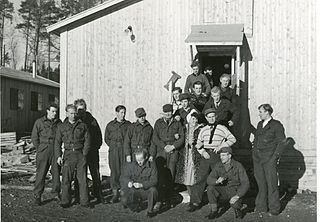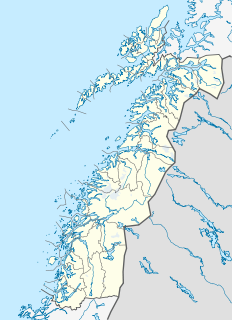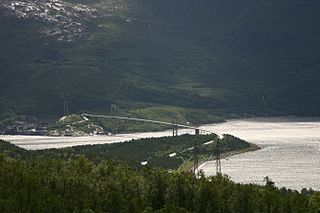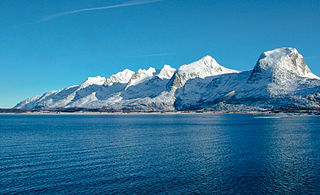
The Norwegian resistance to the occupation of Norway by Nazi Germany began after Operation Weserübung in 1940 and ended in 1945. It took several forms:
The Battles of Narvik were fought from 9 April to 8 June 1940 as a naval battle in the Ofotfjord and as a land battle in the mountains surrounding the north Norwegian city of Narvik as part of the Norwegian Campaign of the Second World War.

The Norwegian Campaign was the attempted Allied liberation of the Scandinavian nation of Norway from Nazi Germany during the early stages of World War II and directly following the German invasion and occupation of the Norwegian mainland and government. It took place from April 9, 1940, until June 10, 1940. The Allied campaign did not succeed, and it resulted in the fleeing of King Haakon VII along with the remainder of the royal family to Great Britain.

The German occupation of Norway during World War II began on 9 April 1940 after German forces invaded the neutral Scandinavian country of Norway. Conventional armed resistance to the German invasion ended on 10 June 1940 and the Germans controlled Norway until the capitulation of German forces in Europe on 8/9 May 1945. Throughout this period, Norway was continuously occupied by the Wehrmacht. Civil rule was effectively assumed by the Reichskommissariat Norwegen, which acted in collaboration with a pro-German puppet government, the Quisling regime, while the Norwegian King Haakon VII and the prewar government escaped to London, where they acted as a government in exile. This period of military occupation is in Norway referred to as the "war years" or "occupation period".
The Battle of Gratangen occurred during the first Norwegian counter-attack in the Narvik Campaign. The Norwegian 6th Division gathered forces to push the Germans out of the Gratangen area and back towards Narvik. The first attack failed disastrously when the Germans counter-attacked unprepared Norwegian forces, routing a battalion and blunting the first Norwegian advance.
Asbjørn Halvorsen, nicknamed Assi, was a Norwegian footballer, who played as a centre-half for Sarpsborg FK and Hamburger SV. He was capped 19 times playing for Norway, and was a part of the Norwegian team who competed in the 1920 Summer Olympics. He was later Secretary general of the Norwegian Football Association, and acted as head coach of the Norwegian national team. He is regarded as the architect behind the Norwegian "Bronze Team" that finished third in the 1936 Olympics.

Hartvikvatnet (Norwegian) or Árajávri (Northern Sami) is a lake in Narvik Municipality in Nordland county, Norway. The 2.3-square-kilometre (0.89 sq mi) lake is located about 4 kilometres (2.5 mi) east of the village of Bjerkvik and just less than 20 kilometres (12 mi) with the border with Sweden. The Elvegårdsmoen military camp lies just west of the lake.

HNoMS Nordkapp was the lead ship of the Nordkapp class of fishery protection vessels. She was launched 18 August 1937 at Horten naval shipyard, with yard number 123. She had one sister ship, HNoMS Senja. Nordkapp was named after the North Cape in Finnmark. As was typical of her class, Nordkapp was very unstable in rough seas and was viewed from the beginning as a second-rate vessel. Nordkapp sailed throughout the Second World War and saw service in several theatres.
Odd Isaachsen Willoch was a Norwegian naval officer who commanded one of the two coastal defence ships defending Narvik during the German invasion of Norway on 9 April 1940.
Konrad Sundlo was a Norwegian officer and politician in Nasjonal Samling before and during Second World War.

SS Barøy was a 424-ton steel-hulled steamship delivered from the Trondhjems mekaniske Værksted shipyard in Trondheim in 1929. She had been ordered by the Norwegian shipping company Ofotens Dampskibsselskab for the local route from the port city of Narvik to the smaller towns of Lødingen and Svolvær. After the company suffered ship losses in the 1940 Norwegian Campaign Barøy was put into Hurtigruten service on the Trondheim–Narvik route. She was sunk with heavy loss of life in a British air attack in the early hours of 13 September 1941.

Skorpa prisoner of war camp was a facility built by the Norwegian 6th Division to hold German prisoners of war during the 1940 Norwegian Campaign of the Second World War. Skorpa was the main PoW camp in Northern Norway and held around 500 civilian and military prisoners when it was shut down at the end of the Norwegian Campaign.

Operation Weserübung was the code name for Germany's assault on Denmark and Norway during the Second World War and the opening operation of the Norwegian Campaign. The name comes from the German for "Operation Weser-Exercise", the Weser being a German river.
Z13 Erich Koellner was a Type 1934A-class destroyer built for Nazi Germany's Kriegsmarine in the late 1930s. At the beginning of World War II, the ship was still working up. In early 1940 she made two successful minelaying sorties off the English coast that claimed six merchant ships. During the early stages of the Norwegian Campaign, Erich Koellner fought in both naval Battles of Narvik in mid-April 1940 and was severely damaged by British ships during the Second Battle of Narvik. The ship was scuttled by her crew shortly afterwards.

Rombaken (Norwegian) or Ruoppat (Northern Sami) is a fjord that branches off of the main Ofotfjorden in Narvik Municipality in Nordland county, Norway. The fjord is about 20 kilometres (12 mi) long and is surrounded by steep mountainsides and the town of Narvik lies on the south shore of the mouth of the fjord. The European route E06 and European route E10 highways run along the northern shores of the fjord. The fjord has two bridge crossings: the Hålogaland Bridge, completed in 2018, crosses at mouth of the Rombaken fjord and the Rombak Bridge which crosses at a narrow point about mid-way down the fjord.

Narvik is a town and the administrative centre of Narvik Municipality in Nordland county, Norway. The town is located along the Ofotfjorden in the Ofoten region. The town lies on a peninsula located between the Rombaken fjord and the Beisfjorden. The European route E06 highway runs through the Beisfjord Bridge and Hålogaland Bridge crossing the two small fjords surrounding the town.

SS Nordnorge was a Norwegian steamship built in 1923–24 by Trondhjems mekaniske Værksted, for the Narvik-based Norwegian shipping company Ofotens Dampskibsselskap. First employed on the company's Narvik-Trondheim route, she was transferred to the longer Hurtigruten route in late 1936. Seized by the Germans following their April 1940 attack on Norway, she was used as covert troop ship and was sunk shortly after delivering her cargo of German troops behind Allied lines on 10 May 1940.
Per Askim was a Norwegian naval officer who was in command of the two coastal defence ships defending Narvik during the German invasion of Norway on 9 April 1940.
Ole Siem was a Norwegian naval officer, businessman and politician.













